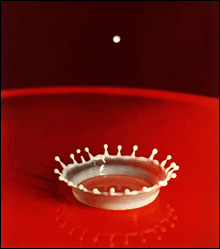 In tonal music and in dance it never happens. In literature it’s as rare as a hen’s tooth. But in photography, though still exceedingly uncommon, it’s not unheard of: the serendipitous creation of art. No orchestral score or ballet ever materialized fully formed by accident, and you’ll probably be able to count on one hand over the course of a lifetime the occasions when a moment of everyday discourse reveals itself to be a poem. (An 1881 death sentence issued in the New Mexico Territory found its way into a literary magazine 30 years ago and I have been treasuring it ever since.) But photography is another matter. The pioneering work of Eadweard Muybridge (1830–1904), who set out to discover whether a horse’s four hooves all leave the ground in a gallop (they do) catalogued the movement of people and animals in a series of images that blurred the line between science and art. In the pursuit of truth he discovered beauty.
In tonal music and in dance it never happens. In literature it’s as rare as a hen’s tooth. But in photography, though still exceedingly uncommon, it’s not unheard of: the serendipitous creation of art. No orchestral score or ballet ever materialized fully formed by accident, and you’ll probably be able to count on one hand over the course of a lifetime the occasions when a moment of everyday discourse reveals itself to be a poem. (An 1881 death sentence issued in the New Mexico Territory found its way into a literary magazine 30 years ago and I have been treasuring it ever since.) But photography is another matter. The pioneering work of Eadweard Muybridge (1830–1904), who set out to discover whether a horse’s four hooves all leave the ground in a gallop (they do) catalogued the movement of people and animals in a series of images that blurred the line between science and art. In the pursuit of truth he discovered beauty. It is fitting that Harold Edgerton, who became an internationally celebrated presence at MIT over the course of his 60-year career as an inventor, teacher, and photographer, was a year and three days old when Muybridge died, since their lives intersect at a profound level. Muybridge’s investigations into animal locomotion (he set up 50 cameras along a racetrack, their shutters triggered by trip wires) aimed at recording images the human eye could witness but not see. Forty-four years after the publication of Muybridge’s Animal Locomotion, Edgerton, then doing graduate studies in engineering at MIT, turned his stroboscope, essentially a high-speed stop-action camera, from the motors he was investigating to the movement of commonplace objects that are also beyond our ability to see: a bullet in flight, a golfer’s swing, the impact on a football when it’s kicked. Those studies constitute the enthralling exhibit at Gallery Kayafas up through June 10. To call it important is an understatement.
It’s too easy to get caught up in the scientific underpinnings of Edgerton’s art — the way the stroboscope freezes the motion of a moving object by being synchronized with its trajectory. It would be like attributing Shakespeare’s greatness to his mastery of iambic pentameter. There’s a whole lot more at stake. By taking as his subject matter the movements of everyday objects — the flow of water from a faucet, a girl jumping rope, a diver springing from a board — Edgerton enhances the sense of mystery and awe the photographs deliver. We’re amazed not by the otherworldliness of his images but by the strangeness of what we’ve presumed we’ve seen. His photos are a version of the fairy tale in which the impoverished child discovers he’s the son of a monarch — wealth we could only dream about turns out to have been ours all along.
 Related
Related:
Collective effort, Eye on you, Feasts and fasts, More 
- Collective effort
Making money watching Tom Brady? Sign me up!
- Eye on you
Oskar Kokoschka is reputed to have asked, if the Louvre were burning and you could rescue either the Mona Lisa or a cat, which would it be? Slideshow: "Super Vision" at the ICA
- Feasts and fasts
Ramadan is a family-oriented month, and Islamic societies at universities around town provide new sets of communities for students.
- Massive attack
A fat house, a fat car . . . no, this isn’t necessarily a disparaging comment on the current state of the American dream.
- Jury’s got the verdict
Two well-judged shows light up the holiday horizon.
- In a bit of a jam
To suck at an electronic endeavor at the Massachusetts Institute of Technology, of all places, is analogous to sucking at, say, making soup at cooking school.
- Prevention suspension
Combating sexual assault is especially tough if your workspace is the size of a professional basketball player's shoebox.
- Crank that, techie
In the summer of 2006, DeAndre Way, then 16, combated summer boredom in Batesville, Mississippi, by writing songs with Fruity Loops digital-audio software.
- Crossword: 'C the USA'
Goddess of discord
- Survive the econopocalypse
If you're like the more than nine percent of Americans currently unemployed, your "Yes We Can!" has lately lost some of its gusto. You've hit up everyone you know for work, including your mom, your ex, and your ex's ex.
- This is your summer . . . on drugs
Ah, those weird Lazy Summer Days (LSDs) in Boston. What to do on them, so as not to go out of your head with boredom?
- Less

 Topics
Topics:
Museum And Gallery
, Politics, Culture and Lifestyle, Food and Cooking, More  , Politics, Culture and Lifestyle, Food and Cooking, Foods, Fruits and Vegetables, Sports, Political Policy, Massachusetts Institute of Technology, International Relations, U.S. Armed Forces, Less
, Politics, Culture and Lifestyle, Food and Cooking, Foods, Fruits and Vegetables, Sports, Political Policy, Massachusetts Institute of Technology, International Relations, U.S. Armed Forces, Less 